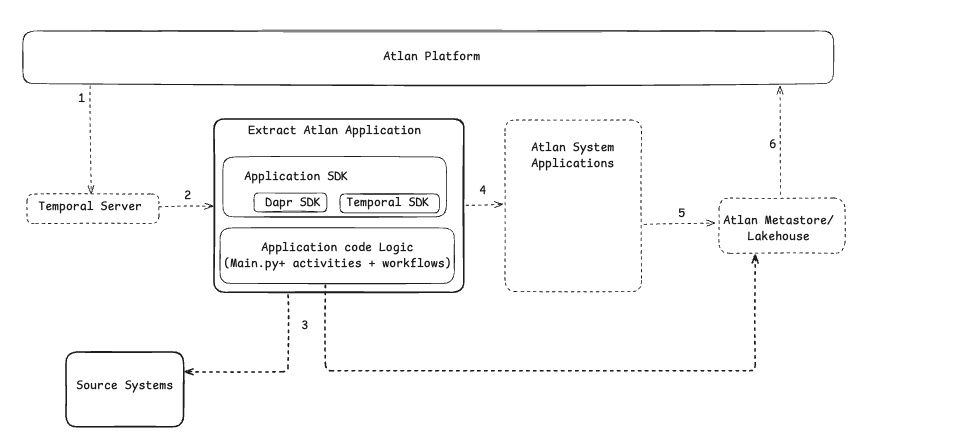Apps framework
Teams need to build custom solutions that unlock metadata context, streamline workflows, and adapt to evolving needs in an AI-native ecosystem. The Atlan Apps Framework addresses this challenge by providing a standardized foundation for extending Atlan with custom apps, integrations, and automations that become first-class citizens within the Atlan ecosystem—inheriting its security model, user experience, and operational guarantees while abstracting away infrastructure complexity.
What you get from framework
The Apps Framework delivers a comprehensive set of capabilities that eliminate common development challenges. These built-in features let you focus on your application's unique value while the framework handles the foundational requirements:
Prebuilt APIs
Every app automatically exposes standardized endpoints for cross-app collaboration
- Standard /metadata endpoints
- Cross-app information sharing
- Platform API extensions
Development toolkit
CLI, SDKs, and testing utilities that accelerate the entire development lifecycle
- Python SDK with examples
- Testing and mocking utilities
- Frontend development support
Reusable components
Pre-built patterns for metadata extraction, batch processing, and event handling
- SQL template extraction
- Batch processing patterns
- Event processing pipelines
UI integration
Native interface extensions that feel like built-in Atlan features
- Configuration interfaces
- Metamodel extensions
- Native UI customization
Key architectural concepts
The framework is designed around three key architectural concepts that address the unique challenges of metadata applications. These concepts guided how the framework is built and what technologies power it.
-
Durable Execution: Applications can define complex, multi-step workflows that survive failures, restarts, and infrastructure changes. This durability is essential for metadata operations that may take hours or days to complete.
-
Event-Driven Architecture: Applications can react to changes in the metadata graph in real-time. When new assets are created, lineage updates occur, or policy violations are detected, your applications can automatically respond with governance actions and automation workflows.
-
Microservice Isolation: Each application runs in its own isolated environment with defined resource boundaries. This prevents one application from affecting others or the core platform while maintaining secure access to shared metadata services.
Core technologies
The architectural foundation is built on modern distributed systems principles, leveraging two key technologies through the underlying Application SDK:
-
Temporal provides durable execution for long-running workflows. In metadata management, many operations are inherently long-running—data quality checks across thousands of assets, lineage impact analysis, or governance policy enforcement. Temporal ensures these workflows complete reliably, even through failures, by automatically persisting state and resuming execution exactly where it left off.
-
Dapr provides building blocks for microservice communication, abstracting away the complexity of service discovery, secure communication, state management, and event-driven patterns. This enables you to focus on business logic rather than distributed systems challenges.
How it works
The framework operates through a layered architecture where your application code defines workflows and activities using Python functions and decorators provided by the Atlan Application SDK. The Application SDK handles workflow registration with Temporal and provides secure access to Atlan APIs through Dapr integration.

The execution flow follows six key steps shown in the architecture diagram:
1. Workflow Trigger: The Atlan platform triggers a workflow execution by sending a request to the Temporal server, initiating the metadata processing pipeline.
2. Application Orchestration: Temporal server orchestrates the execution by dispatching work to your extract application, which contains both the Application SDK and your custom application code.
3. Source System Integration: Your extract application connects to and retrieves data from external source systems, handling authentication, data extraction, and transformation logic.
4. System Application Processing: The extracted data is processed and sent to Atlan system applications, which handle metadata standardization, enrichment, and validation.
5. Metadata Storage: System applications persist the processed metadata to Atlan's metadata store, ensuring data consistency, versioning, and relationship mapping.
6. Platform Integration: The metadata store updates the Atlan platform, making the new metadata available through the user interface, APIs, and other platform services.
See also
- Application Architecture: Technical deep dive into the architecture of applications built with the SDK
- Sample Apps: Explore ready-to-use application examples